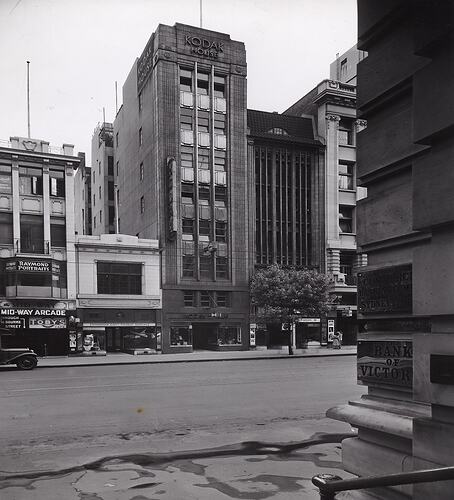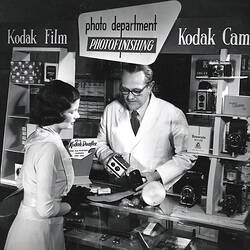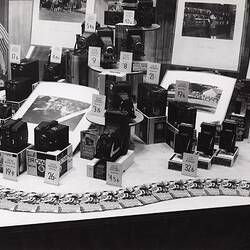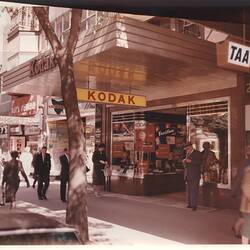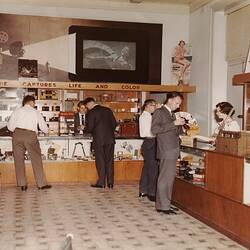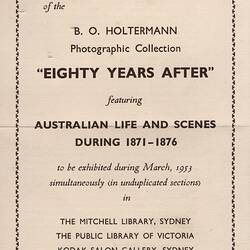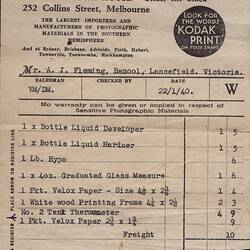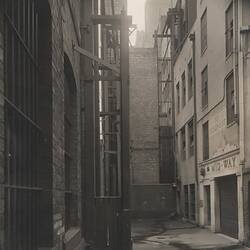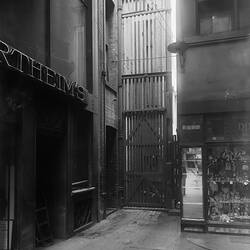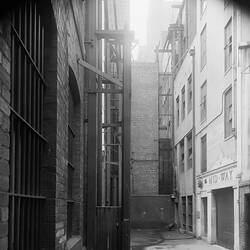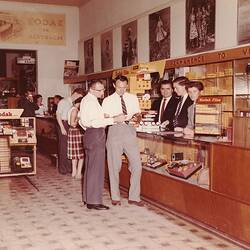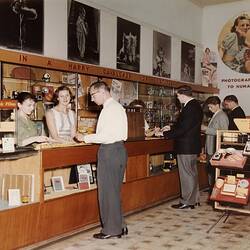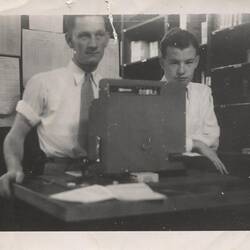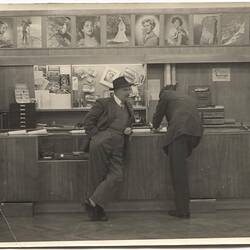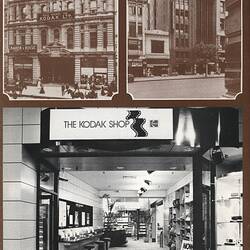Kodak House was a brand new, multistorey retail premises opened by Kodak Australasia in 1935 at 252 Collins Street, Melbourne. Denoting status and modern grandeur, the building used large quantities of stainless steel throughout, a polished red granite and terracotta exterior, and a large octagonal clock on the front of the building as a decorative signpost (Beale, p 42).
A retail outlet on the ground floor was the focal point of the building, but there was a Ciné-Kodak showroom, film library and theatrette in the basement level, plus wholesale and professional sales on the second floor, and repairs and maintenance on the third (Beale, p 42). The remaining floors were leased to other businesses, including Hugh Berry & Co who moved in circa 1957 and worked with Kodak on their advertising campaigns (Kerr, 2012). In the mid-1960s, Kodak wholesale and retail branch administration moved into the remaining floors.
In the 1950s, prior to any major renovations, the store was long and narrow and had counters on either side, packed with product, and staffed by six people per counter (Harvey, 2014). The interior was rich with brass, wood and glass fixtures, framed photographs and advertising posters. Black and white photography was a significant part of the business in those early years.
John Harvey (2014), who began his Kodak sales career at Collins Street in 1958, recalls the experience of entering the building:
"[...]two thirds of the way up the shop there were about three steps, and you went up, and on the left hand side there was the second hand department, and on the right hand was the Kodachrome printing department [.] up the stairs you went to the mezzanine, which is Roy Barcham's Victorian Sales manager's office, first floor was the Cine Department where they also rented movies, 16mm movies, and edited and repaired them. Joy Bowen was the woman that ran that for years. And Ernest, Ern Brideson was the head of the movie sales department, selling 8mm cameras."
A new look modern merchandising and sales area was launched around late 1965 using open display units that allowed customers to browse products themselves, and new counters. The launch was reported in the Kodak publication 'Sales News', issued January 15th 1966.
John Kerr recalls reworking the interior after he started as Sales Manager in 1967, bringing the decor up to modern merchandising standards and making the place feel less nostalgic and more accessible (Kerr, 2012). His team introduced self-service collection for processed orders as well as refreshing the interior décor and promotional material:
"[.]we put up new modern images on the walls, of, you know, girls in bikinis, and guys having fun on the beach, or people skiing, or families, or animal pictures [.] over the next two years, we doubled the retail sales, due to this new approach." (Kerr, 2012)
Kodak House Collins Street operated in the mid-20th century during a period of peak sales and company growth for Kodak. The Kodak sales offices moved to Coburg in 1979 and the retail shop finally closed in 1983, replaced by a new Collins Street premises at number 270, in Australia Arcade, which was designed using principles tested in the Coburg plant's retail store a year earlier.
References
'Building & Architecture', The Age (Melbourne, Vic. : 1854 - 1954), 10 Jul 1934, p. 15., viewed 13 Apr 2017, http://nla.gov.au/nla.news-article205533022
'Advertising', The Age (Melbourne, Vic. : 1854 - 1954), 15 Feb 1938, p. 12., viewed 13 Apr 2017, http://nla.gov.au/nla.news-article206742123
'Sales News', Kodak Australasia, January 15th 1966, p.1 (HT 53168).
Australian Kodakery, 1983, No. 149, p.7.
Beale, N., 1983 'The History of Kodak in Australia'.
John Harvey in an interview recorded by Lesley Alves, 10 April 2014, Melbourne Museum, Victoria.
John Kerr in an interview recorded by Fiona Kinsey, 28 June 2012, Melbourne Museum, Victoria.
More Information
-
Keywords
Photography, Advertising, Retailing, Promotional Materials, Shopfronts
-
Authors
-
Article types
